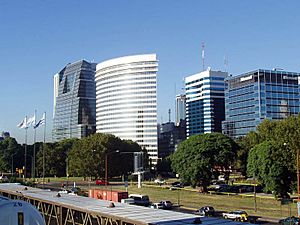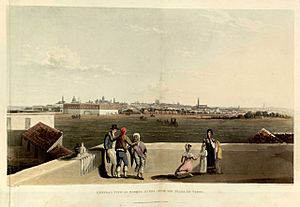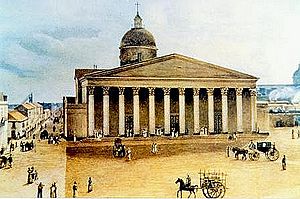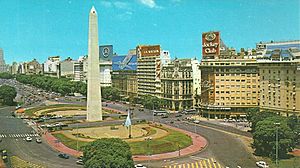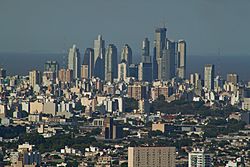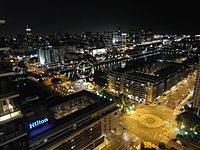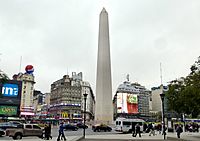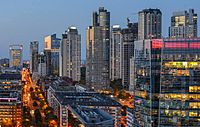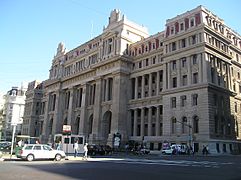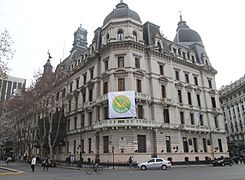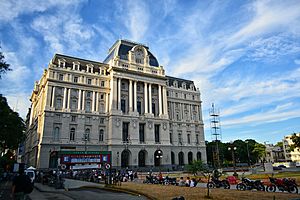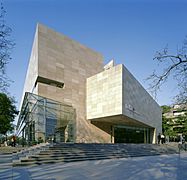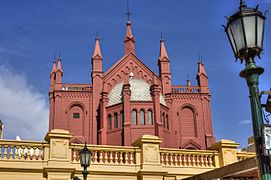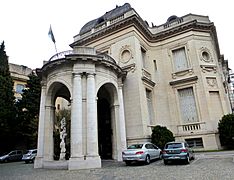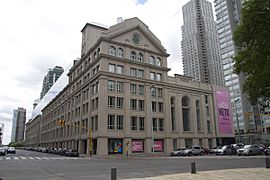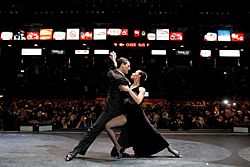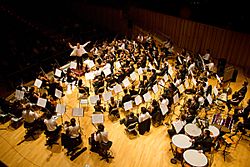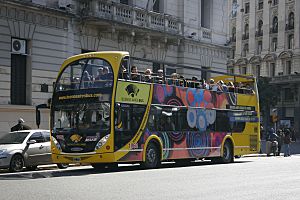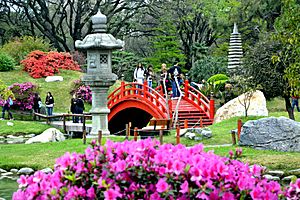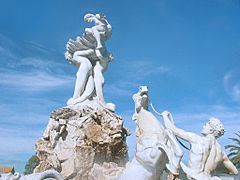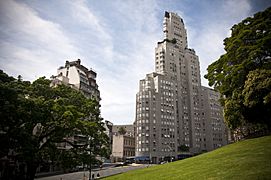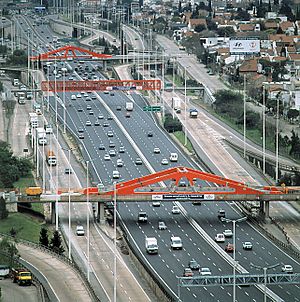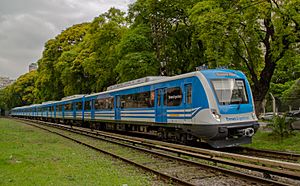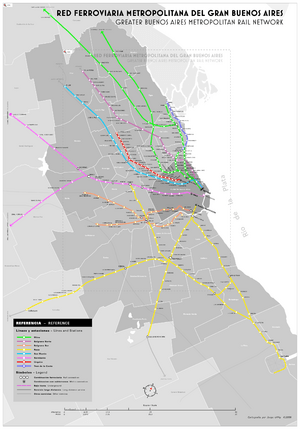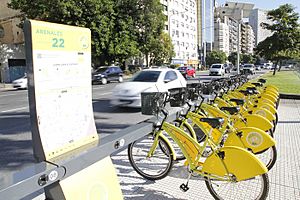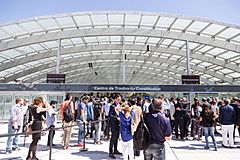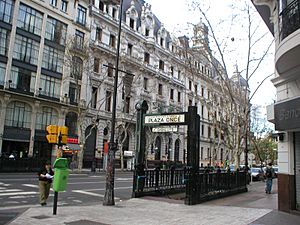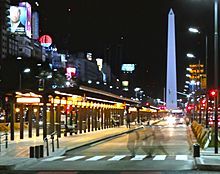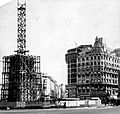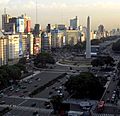Buenos Aires facts for kids
Quick facts for kids
Autonomous City of Buenos Aires
|
|||
|---|---|---|---|
|
Autonomous City
|
|||
| Ciudad Autónoma de Buenos Aires | |||
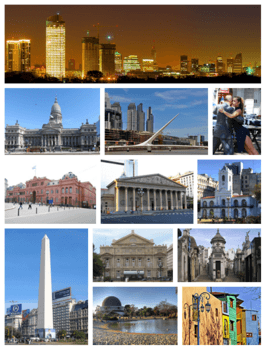
From top (left to right): skyline of the city at dusk, the National Congress, the Woman's Bridge in Puerto Madero, Tango dancers in San Telmo, the Pink House, the Metropolitan Cathedral, Cabildo, the Obelisk, Colón Theatre, La Recoleta Cemetery, the Planetarium in the Palermo Woods, and Caminito in La Boca.
|
|||
|
|||
| Nickname(s): | |||
| Country | Argentina | ||
| Established | 1536, 1580 | ||
| Government | |||
| • Type | Autonomous city | ||
| Area | |||
| • Autonomous City | 203 km2 (78.5 sq mi) | ||
| • Land | 203 km2 (78.5 sq mi) | ||
| • Metro | 4,758 km2 (1,837 sq mi) | ||
| Elevation | 25 m (82 ft) | ||
| Population
(2010 census.)
|
|||
| • Autonomous City | 2,890,151 | ||
| • Density | 14,240/km2 (36,817/sq mi) | ||
| • Metro | 12,801,364 | ||
| Demonym(s) | porteño (m), porteña (f) | ||
| Time zone | UTC−3 (ART) | ||
| Area code(s) | 011 | ||
| HDI (2010) | 0.953 – Very High | ||
| Website | (Spanish) bue.gov.ar (English) | ||
Buenos Aires is the capital and largest city in the South American country of Argentina.
Buenos Aires city is also known as Capital Federal to differentiate the city from the Buenos Aires Province.
Until 1994 Buenos Aires city was under the presidential government, but after a constitutional reform in that year, the city became self-governed, allowing citizens to elect their city authorities.
Contents
History
Colonial times
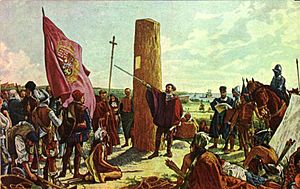
Seaman Juan Díaz de Solís, navigating in the name of Spain, was the first European to reach the Río de la Plata in 1516. His expedition was cut short when he was killed during an attack by the native Charrúa tribe in what is now Uruguay.
The city of Buenos Aires was first established as Ciudad de Nuestra Señora Santa María del Buen Ayre (literally "City of Our Lady Saint Mary of the Fair Winds") after Our Lady of Bonaria (Patroness Saint of Sardinia) on 2 February 1536 by a Spanish expedition led by Pedro de Mendoza. The settlement founded by Mendoza was located in what is today the San Telmo district of Buenos Aires, south of the city centre.
More attacks by the indigenous people forced the settlers away, and in 1542 the site was abandoned. A second (and permanent) settlement was established on 11 June 1580 by Juan de Garay, who arrived by sailing down the Paraná River from Asunción (now the capital of Paraguay). He dubbed the settlement "Santísima Trinidad" and its port became "Puerto de Santa María de los Buenos Aires."
From its earliest days, Buenos Aires depended primarily on trade. During most of the 17th and 18th centuries, Spanish ships were menaced by pirates, so they developed a complex system where ships with military protection were dispatched to Central America, cross the land, from there to Lima, Peru and from it to the inner cities of the viceroyalty. Because of this, products took a very long time to arrive in Buenos Aires, and the taxes generated by the transport made them prohibitive. This scheme frustrated the traders of Buenos Aires, and a thriving contraband industry developed. This also instilled a deep resentment among porteños towards the Spanish authorities.
Sensing these feelings, Charles III of Spain progressively eased the trade restrictions and finally declared Buenos Aires an open port in the late 18th century. The capture of Porto Bello by British forces also fueled the need to foster commerce via the Atlantic route, to the detriment of Lima-based trade. One of his rulings was to split a region from the Viceroyalty of Perú and create instead the Viceroyalty of the Río de la Plata, with Buenos Aires as the capital. However, Charles's placating actions did not have the desired effect, and the porteños, some of them versed in the ideology of the French Revolution, became even more convinced of the need for independence from Spain.
War of independence
During the British invasions of the Río de la Plata, British forces attacked Buenos Aires twice. In 1806 the British successfully invaded Buenos Aires, but an army from Montevideo led by Santiago de Liniers defeated them. In the brief period of British rule, the viceroy Rafael Sobremonte managed to escape to Córdoba and designated this city as capital. Buenos Aires became the capital again after its liberation, but Sobremonte could not resume his duties as viceroy. Santiago de Liniers, chosen as new viceroy, prepared the city against a possible new British attack and repelled the attempted invasion of 1807. The militarization generated in society changed the balance of power favorably for the criollos (in contrast to peninsulars), as well as the development of the Peninsular War in Spain. An attempt by the peninsular merchant Martín de Álzaga to remove Liniers and replace him with a Junta was defeated by the criollo armies. However, by 1810 it would be those same armies who would support a new revolutionary attempt, successfully removing the new viceroy Baltasar Hidalgo de Cisneros. This is known as the May Revolution, which is now celebrated as a national holiday. This event started the Argentine War of Independence, and many armies left Buenos Aires to fight the diverse strongholds of royalist resistance, with varying levels of success. The government was held first by two Juntas of many members, then by two triumvirates, and finally by a unipersonal office, the Supreme Director. Formal independence from Spain was declared in 1816, at the Congress of Tucumán. Buenos Aires managed to endure the whole Spanish American wars of independence without falling again under royalist rule.
Historically, Buenos Aires has been Argentina's main venue of liberal, free-trading and foreign ideas, while many of the provinces, especially those to the north-west, advocated a more nationalistic and Catholic approach to political and social issues. Much of the internal tension in Argentina's history, starting with the centralist-federalist conflicts of the 19th century, can be traced back to these contrasting views. In the months immediately following the 25 May Revolution, Buenos Aires sent a number of military envoys to the provinces with the intention of obtaining their approval. Many of these missions ended in violent clashes, and the enterprise fuelled tensions between the capital and the provinces.
In the 19th century the city was blockaded twice by naval forces: by the French from 1838 to 1840, and later by an Anglo-French expedition from 1845 to 1848. Both blockades failed to force the city into submission, and the foreign powers eventually desisted from their demands.
19th and 20th century
During most of the 19th century, the political status of the city remained a sensitive subject. It was already the capital of Buenos Aires Province, and between 1853 and 1860 it was the capital of the seceded State of Buenos Aires. The issue was fought out more than once on the battlefield, until the matter was finally settled in 1880 when the city was federalized and became the seat of government, with its mayor appointed by the president. The Casa Rosada became the seat of the president.
Health conditions in poor areas were negative, with high rates of tuberculosis. Public-health physicians and politicians typically blamed both the poor themselves and their ramshackle tenement houses (conventillos) for the spread of the dreaded disease. People ignored public-health campaigns to limit the spread of contagious diseases, such as the prohibition of spitting on the streets, the strict guidelines to care for infants and young children, and quarantines that separated families from ill loved ones.
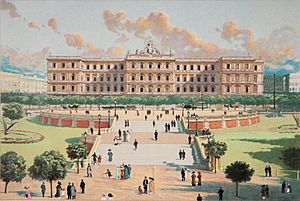
In addition to the wealth generated by the Buenos Aires Customs and the fertile pampas, railroad development in the second half of the 19th century increased the economic power of Buenos Aires as raw materials flowed into its factories. A leading destination for immigrants from Europe, particularly Italy and Spain, from 1880 to 1930 Buenos Aires became a multicultural city that ranked itself with the major European capitals. The Colón Theater became one of the world's top opera venues, and the city became the regional capital of radio, television, cinema, and theatre. The city's main avenues were built during those years, and the dawn of the 20th century saw the construction of South America's then-tallest buildings and its first underground system. A second construction boom, from 1945 to 1980, reshaped downtown and much of the city.

Buenos Aires also attracted migrants from Argentina's provinces and neighboring countries. Shanty towns (villas miseria) started growing around the city's industrial areas during the 1930s, leading to pervasive social problems and social contrasts with the largely upwardly-mobile Buenos Aires population. These laborers became the political base of Peronism, which emerged in Buenos Aires during the pivotal demonstration of 17 October 1945, at the Plaza de Mayo. Industrial workers of the Greater Buenos Aires industrial belt have been Peronism's main support base ever since, and Plaza de Mayo became the site for demonstrations and many of the country's political events; on 16 June 1955, however, a splinter faction of the Navy bombed the Plaza de Mayo area, killing 364 civilians (see Bombing of Plaza de Mayo). This was the only time the city was attacked from the air, and the event was followed by a military uprising which deposed President Perón, three months later.
21st century
In 1996, following the 1994 reform of the Argentine Constitution, the city held its first mayoral elections under the new statutes, with the mayor's title formally changed to "Head of Government". The winner was Fernando de la Rúa, who would later become President of Argentina from 1999 to 2001.
De la Rúa's successor, Aníbal Ibarra, won two popular elections, but was impeached (and ultimately deposed on 6 March 2006) as a result of the fire at the República Cromagnon nightclub. Jorge Telerman, who had been the acting mayor, was invested with the office. In the 2007 elections, Mauricio Macri of the Republican Proposal (PRO) party won the second-round of voting over Daniel Filmus of the Frente para la Victoria (FPV) party, taking office on 9 December 2007. In 2011, the elections went to a second round with 60.96% of the vote for PRO, compared to 39.04% for FPV, thus re-electing Macri as mayor of the city with María Eugenia Vidal as deputy mayor.
The 2015 elections were the first to use an electronic voting system in the city, similar to the one used in Salta Province. In these elections held on 5 July 2015, Macri stepped down as mayor and pursue his presidential bid and Horacio Rodríguez Larreta took his place as the mayoral candidate for PRO. In the first round of voting, FPV's Mariano Recalde obtained 21.78% of the vote, while Martín Lousteau of the ECO party obtained 25.59% and Larreta obtained 45.55%, meaning that the elections went to a second round since PRO was unable to secure the majority required for victory. The second round was held on 19 July 2015 and Larreta obtained 51.6% of the vote, followed closely by Lousteau with 48.4%, thus, PRO won the elections for a third term with Larreta as mayor and Diego Santilli as deputy. In these elections, PRO was stronger in the wealthier neighbourhoods of northern Buenos Aires, while ECO was stronger in the south of the city.
-
View of 9 de Julio Avenue with the Obelisk
Geography
The city of Buenos Aires lies in the pampa region, except for some zones like the Buenos Aires Ecological Reserve, the Boca Juniors (football) Club "sports city", Jorge Newbery Airport, the Puerto Madero neighborhood and the main port itself; these were all built on reclaimed land along the coasts of the Rio de la Plata (the world's widest river).
The region was formerly crossed by different streams and lagoons, some of which were refilled and others tubed. Among the most important streams are Maldonado, Vega, Medrano, Cildañez and White. In 1908 many streams were channelled and rectified, as floods were damaging the city's infrastructure. Starting in 1919, most streams were enclosed. Notably, the Maldonado was tubed in 1954, and runs below Juan B. Justo Avenue.
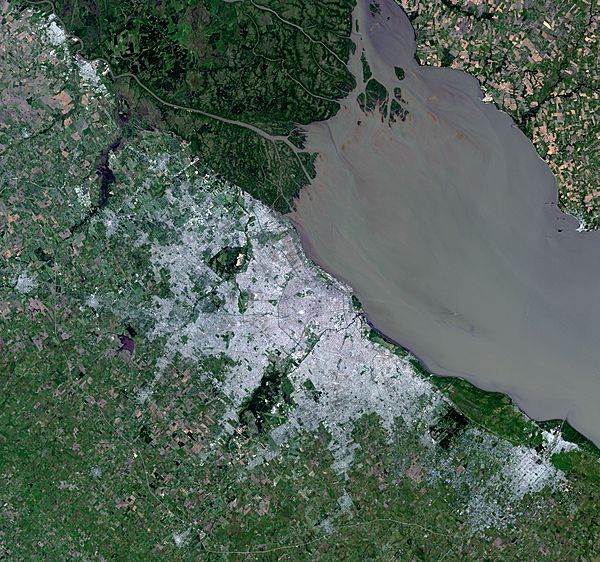
Climate
Under Köppen climate classification, Buenos Aires has a humid subtropical climate (Cfa) with four distinct seasons. As a result of maritime influences from the adjoining Atlantic Ocean, the climate is temperate with extreme temperatures being rare. Because the city is located in an area where the Pampero and Sudestada winds pass by, the weather is variable due to these contrasting air masses.
Summers are hot and humid. The warmest month is January, with a daily average of 24.9 °C (76.8 °F). Heat waves are common during summers. However, most heat waves are of short duration (less than a week) and are followed by the passage of the cold, dry Pampero wind which brings violent and intense thunderstorms followed by cooler temperatures. The highest temperature ever recorded was 43.3 °C (110 °F) on 29 January 1957.
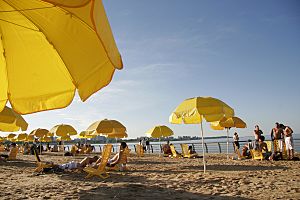
Winters are cold with mild temperatures during the day and cold nights. Highs during the season average 16.3 °C (61.3 °F) while lows average 8.1 °C (46.6 °F). Relative humidity averages in the upper 70s%, which means the city is noted for moderate-to-heavy fogs during autumn and winter. July is the coolest month, with an average temperature of 11.0 °C (51.8 °F). Cold spells originating from Antarctica occur almost every year, and can persist for several days. Occasionally, warm air masses from the north bring warmer temperatures. The lowest temperature ever recorded in central Buenos Aires (Buenos Aires Central Observatory) was −5.4 °C (22 °F) on 9 July 1918. Snow is very rare in the city: the last snowfall occurred on 9 July 2007 when, during the coldest winter in Argentina in almost 30 years, severe snowfalls and blizzards hit the country. It was the first major snowfall in the city in 89 years.
Spring and autumn are characterized by changeable weather conditions. Cold air from the south can bring cooler temperatures while hot humid air from the north bring hot temperatures.
The city receives 1,236.3 mm (49 in) of precipitation per year. Because of its geomorphology along with an inadequate drainage network, the city is highly vulnerable to flooding during periods of heavy rainfall.
| Climate data for Buenos Aires Central Observatory, located in Villa Ortúzar (1981–2010) | |||||||||||||
|---|---|---|---|---|---|---|---|---|---|---|---|---|---|
| Month | Jan | Feb | Mar | Apr | May | Jun | Jul | Aug | Sep | Oct | Nov | Dec | Year |
| Average high °C (°F) | 30.1 (86.2) |
28.6 (83.5) |
26.8 (80.2) |
22.9 (73.2) |
19.3 (66.7) |
16.0 (60.8) |
15.4 (59.7) |
17.7 (63.9) |
19.3 (66.7) |
22.6 (72.7) |
25.6 (78.1) |
28.5 (83.3) |
22.7 (72.9) |
| Daily mean °C (°F) | 24.9 (76.8) |
23.6 (74.5) |
21.9 (71.4) |
17.9 (64.2) |
14.5 (58.1) |
11.7 (53.1) |
11.0 (51.8) |
12.8 (55.0) |
14.6 (58.3) |
17.8 (64.0) |
20.7 (69.3) |
23.3 (73.9) |
17.9 (64.2) |
| Average low °C (°F) | 20.1 (68.2) |
19.3 (66.7) |
17.7 (63.9) |
13.8 (56.8) |
10.7 (51.3) |
8.0 (46.4) |
7.4 (45.3) |
8.8 (47.8) |
10.3 (50.5) |
13.3 (55.9) |
15.9 (60.6) |
18.4 (65.1) |
13.6 (56.5) |
| Average precipitation mm (inches) | 138.8 (5.46) |
127.1 (5.00) |
140.1 (5.52) |
119.0 (4.69) |
92.3 (3.63) |
58.8 (2.31) |
60.6 (2.39) |
64.2 (2.53) |
72.0 (2.83) |
127.2 (5.01) |
117.3 (4.62) |
118.9 (4.68) |
1,236.3 (48.67) |
| Average precipitation days (≥ 0.1 mm) | 9 | 8 | 9 | 9 | 7 | 7 | 7 | 7 | 7 | 10 | 10 | 9 | 99 |
| Mean monthly sunshine hours | 279.0 | 240.8 | 229.0 | 220.0 | 173.6 | 132.0 | 142.6 | 173.6 | 189.0 | 227.0 | 252.0 | 266.6 | 2,525.2 |
| Source 1: Servicio Meteorológico Nacional | |||||||||||||
| Source 2: Deutscher Wetterdienst (sun, 1961–1990) | |||||||||||||
Government and politics
Government structure
The Executive is held by the Chief of Government (Spanish: Jefe de Gobierno), elected for a four-year term together with a Deputy Chief of Government, who presides over the 60-member Buenos Aires City Legislature. Each member of the Legislature is elected for a four-year term; half of the legislature is renewed every two years. Elections use the D'Hondt method of proportional representation. The Judicial branch is composed of the Supreme Court of Justice (Tribunal Superior de Justicia), the Magistrate's Council (Consejo de la Magistratura), the Public Ministry, and other City Courts. Article 61 of the 1996 Constitution of the City of Buenos Aires states that "Suffrage is free, equal, secret, universal, compulsory and non-accumulative. Resident aliens enjoy this same right, with its corresponding obligations, on equal terms with Argentine citizens registered in the district, under the terms established by law."
-
Casa Rosada, workplace of the President of Argentina is in the Monserrat neighbourhood
-
The Palace of Justice of the Argentine Nation is in the San Nicolás, Buenos Aires neighbourhood
Demographics
The population of Buenos Aires proper has hovered around 3 million since 1947, due to low birth rates and a slow migration to the suburbs. The surrounding districts have, however, expanded over fivefold (to around 10 million) since then.
The 2001 census showed a relatively aged population: with 17% under the age of fifteen and 22% over sixty, the people of Buenos Aires have an age structure similar to those in most European cities. They are older than Argentines as a whole (of whom 28% were under 15, and 14% over 60).
Two-thirds of the city's residents live in apartment buildings and 30% in single-family homes; 4% live in sub-standard housing. Measured in terms of income, the city's poverty rate was 8.4% in 2007 and, including the metro area, 20.6%. Other studies estimate that 4 million people in the metropolitan Buenos Aires area live in poverty.
Culture
Strongly influenced by European culture, Buenos Aires is sometimes referred to as the "Paris of South America". The city has the busiest live theatre industry in Latin America, with scores of theaters and productions. In fact, every weekend, there are about 300 active theatres with plays, a number that places the city as 1st worldwide, more than either London, New York or Paris, cultural Meccas in themselves. The number of cultural festivals with more than 10 sites and 5 years of existence also places the city as 2nd worldwide, after Edinburgh. The Kirchner Cultural Centre located in Buenos Aires, is the largest of Latin America, and the third worldwide.
Buenos Aires is the home of the Teatro Colón, an internationally rated opera house. There are several symphony orchestras and choral societies. The city has numerous museums related to history, fine arts, modern arts, decorative arts, popular arts, sacred art, arts and crafts, theatre and popular music, as well as the preserved homes of noted art collectors, writers, composers and artists. The city is home to hundreds of bookstores, public libraries and cultural associations (it is sometimes called "the city of books"), as well as the largest concentration of active theatres in Latin America. It has a world-famous zoo and botanical garden, a large number of landscaped parks and squares, as well as churches and places of worship of many denominations, many of which are architecturally noteworthy.
Art
Buenos Aires has a thriving arts culture, with "a huge inventory of museums, ranging from obscure to world-class." The barrios of Palermo and Recoleta are the city's traditional bastions in the diffusion of art, although in recent years there has been a tendency of appearance of exhibition venues in other districts such as Puerto Madero or La Boca; renowned venues include MALBA, the National Museum of Fine Arts, Fundación Proa, Faena Arts Center, and the Usina del Arte. Other popular institutions are the Buenos Aires Museum of Modern Art, the Quinquela Martín Museum, the Evita Museum, the Fernández Blanco Museum, the José Hernández Museum, and the Palais de Glace, among others. A traditional event that occurs once a year is La Noche de los Museos ("Night of the Museums"), when the city's museums, universities, and artistic spaces open their doors for free until early morning; it usually takes place in November.
Buenos Aires has been the birthplace of several artists and movements of national and international relevance, and has become a central motif in Argentine artistic production, specially since the 20th century. Examples include: the Paris Group - so named for being influenced by the School of Paris - constituted by Antonio Berni, Aquiles Badi, Lino Enea Spilimbergo, Raquel Forner and Alfredo Bigatti, among others; and the La Boca artists - including Benito Quinquela Martín and Alfredo Lazzari, among others - who mostly came from Italy or were of Italian descent, and usually painted scenes from this working-class port neighbourhood. During the 1960s, the Torcuato di Tella Institute - located in Florida Street - became a leading local center for pop art, performance art, installation art, experimental theatre, and conceptual art; this generation of artists included Marta Minujín, Dalila Puzzovio, David Lamelas and Clorindo Testa.
Language
Known as Rioplatense Spanish, Buenos Aires' Spanish (as that of other cities like Rosario and Montevideo, Uruguay) is characterised by voseo, yeísmo and aspiration of s in various contexts. It is heavily influenced by the dialects of Spanish spoken in Andalusia and Murcia.
In the early 20th century, Argentina absorbed millions of immigrants, many of them Italians, who spoke mostly in their local dialects (mainly Neapolitan, Sicilian and Genoese). Their adoption of Spanish was gradual, creating a pidgin of Italian dialects and Spanish that was called cocoliche. Its usage declined around the 1950s. A phonetic study conducted by the Laboratory for Sensory Investigations of CONICET and the University of Toronto showed that the prosody of porteño is closer to the Neapolitan language of Italy than to any other spoken language.
Many Spanish immigrants were from Galicia, and Spaniards are still generically referred to in Argentina as gallegos (Galicians). Galician language, cuisine and culture had a major presence in the city for most of the 20th century. In recent years, descendants of Galician immigrants have led a mini-boom in Celtic music (which also highlighted the Welsh traditions of Patagonia).
Yiddish was commonly heard in Buenos Aires, especially in the Balvanera garment district and in Villa Crespo until the 1960s. Most of the newer immigrants learn Spanish quickly and assimilate into city life.
The Lunfardo argot originated within the prison population, and in time spread to all porteños. Lunfardo uses words from Italian dialects, from Brazilian Portuguese, from African and Caribbean languages and even from English. Lunfardo employs humorous tricks such as inverting the syllables within a word (vesre). Today, Lunfardo is mostly heard in tango lyrics; the slang of the younger generations has been evolving away from it.
Music
According to the Harvard Dictionary of Music, "Argentina has one of the richest art music traditions and perhaps the most active contemporary musical life" in South America. Buenos Aires boasts of several professional orchestras, including the Argentine National Symphony Orchestra, the Ensamble Musical de Buenos Aires and the Camerata Bariloche; as well as various conservatories that offer professional music education, like the Conservatorio Nacional Superior de Música. As a result of the growth and commercial prosperity of the city in the late 18th century, the theatre became a vital force in Argentine musical life, offering Italian and French operas and Spanish zarzuelas. Italian music was very influential during the 19th century and the early 20th century, in part because of immigration, but operas and salon music were also composed by Argentines, including Francisco Hargreaves and Juan Gutiérrez. A nationalist trend that drew from Argentine traditions, literature and folk music was an important force during the 19th century, including composers Alberto Williams, Julián Aguirre, Arturo Berutti and Felipe Boero. In the 1930s, composers such as Juan Carlos Paz and Alberto Ginastera "began to espouse a cosmopolitan and modernist style, influenced by twelve-tone techniques and serialism"; while avant-garde music thrived by the 1960s, with the Rockefeller Foundation financing the Centro Interamericano de Altos Estudios Musicales, which brought internationally famous composers to work and teach in Buenos Aires, also establishing an electronic music studio.
The Río de la Plata is known for being the birthplace of tango, which is considered an emblem of Buenos Aires. The city considers itself the Tango World Capital, and as such hosts many related events, the most important being an annual festival and world tournament. The most important exponent of the genre is Carlos Gardel, followed by Aníbal Troilo; other important composers include Alfredo Gobbi, Ástor Piazzolla, Osvaldo Pugliese, Mariano Mores, Juan D'Arienzo and Juan Carlos Cobián. Tango music experienced a period of splendor during the 1940s, while in the 1960s and 1970s nuevo tango appeared, incorporating elements of classical and jazz music. A contemporary trend is neotango (also known as electrotango), with exponents such as Bajofondo and Gotan Project. On 30 September 2009, UNESCO's Intergovernmental Committee of Intangible Heritage declared tango part of the world's cultural heritage, making Argentina eligible to receive financial assistance in safeguarding tango for future generations.
The city hosts several music festivals every year. A popular genre is electronic dance music, with festivals including Creamfields BA, SAMC, Moonpark, and a local edition of Ultra Music Festival. Other well-known events include the Buenos Aires Jazz Festival, Personal Fest, Quilmes Rock and Pepsi Music. Some music festivals are held in Greater Buenos Aires, like Lollapalooza, which takes place at the Hipódromo de San Isidro in San Isidro.
Cityscape
Architecture
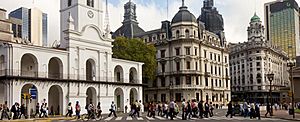
Buenos Aires architecture is characterized by its eclectic nature, with elements resembling Paris and Madrid. There is a mix, due to immigration, of Colonial, Art Deco, Art Nouveau, Neo-Gothic and French Bourbon styles. Italian and French influences increased after the declaration of independence at the beginning of the 19th century, though the academic style persisted until the first decades of the 20th century.
Attempts at renovation took place during the second half of the 19th century and the beginning of the 20th, when European influences penetrated into the country, reflected by several buildings of Buenos Aires such as the Iglesia Santa Felicitas by Ernesto Bunge; the Palace of Justice, the National Congress, all of them by Vittorio Meano, and the Teatro Colón, by Francesco Tamburini and Vittorio Meano.
The simplicity of the Rioplatense baroque style can be clearly seen in Buenos Aires through the works of Italian architects such as André Blanqui and Antonio Masella, in the churches of San Ignacio, Nuestra Señora del Pilar, the Cathedral and the Cabildo.
In 1912 the Basilica del Santisimo Sacramento was opened to the public. Totally built by the generous donation of Mrs. Mercedes Castellanos de Anchorena, Argentina's most prominent family, the church is an excellent example of French neo-classicism. With extremely high-grade decorations in its interior, the magnificent Mutin-Cavaillé coll organ (the biggest ever installed in an Argentine church with more than four-thousand tubes and four manuals) presided the nave. The altar is full of marble, and was the biggest ever built in South America at that time.
In 1919 the construction of Palacio Barolo began. This was South America's tallest building at the time, and was the first Argentine skyscraper built with concrete (1919–1923). The building was equipped with 9 elevators, plus a 20-metre high lobby hall with paintings in the ceiling and Latin phrases embossed in golden bronze letters. A 300,000-candela beacon was installed at the top (110 m), making the building visible even from Uruguay. In 2009 the Barolo Palace went under an exhausive restoration, and the beacon was made operational again.
In 1936 the Kavanagh building was inaugurated, with 120 metres (390 feet) height, 12 elevators (provided by Otis) and the world's first central air-conditioning system (provided by north-American company "Carrier"), is still an architectural landmark in Buenos Aires.
The architecture of the second half of the 20th century continued to reproduce French neoclassic models, such as the headquarters of the Banco de la Nación Argentina built by Alejandro Bustillo, and the Museo Hispanoamericano de Buenos Aires of Martín Noel. However, since the 1930s the influence of Le Corbusier and European rationalism consolidated in a group of young architects from the University of Tucumán, among whom Amancio Williams stands out. The construction of skyscrapers proliferated in Buenos Aires until the 1950s. Newer modern high-technology buildings by Argentine architects in the last years of the 20th century and the beginning of the 21st include the Le Parc Tower by Mario Álvarez, the Torre Fortabat by Sánchez Elía and the Repsol-YPF tower by César Pelli.
Tourism
According to the World Travel & Tourism Council, tourism has been growing in the Argentine capital since 2002. In a survey by the travel and tourism publication Travel + Leisure Magazine in 2008, travellers voted Buenos Aires the second most desirable city to visit after Florence, Italy. In 2008, an estimated 2.5 million visitors visited the city.
The most popular tourist sites are found in the historic core of the city, in the Montserrat and San Telmo neighborhoods. Buenos Aires was conceived around the Plaza de Mayo, the colony's administrative center. To the east of the square is the Casa Rosada, the official seat of the executive branch of the government of Argentina. To the north, the Catedral Metropolitana which has stood in the same location since colonial times, and the Banco de la Nación Argentina building, a parcel of land originally owned by Juan de Garay. Other important colonial institutions were Cabildo, to the west, which was renovated during the construction of Avenida de Mayo and Julio A. Roca. To the south is the Congreso de la Nación (National Congress), which currently houses the Academia Nacional de la Historia (National Academy of History). Lastly, to the northwest, is City Hall.
Parks
Buenos Aires has over 250 parks and green spaces, the largest concentration of which are on the city’s eastern side in the Puerto Madero, Recoleta, Palermo and Belgrano neighbourhoods. Some of the most important are:
- Parque Tres de Febrero, designed by urbanist Jordán Czeslaw Wysocki and architect Julio Dormal, the park was inaugurated on 11 November 1875. The dramatic economic growth of Buenos Aires afterwards helped to lead to its transfer to the municipal domain in 1888, whereby French Argentine urbanist Carlos Thays was commissioned to expand and further beautify the park, between 1892 and 1912. Thays designed the Zoological Gardens, the Botanical Gardens, the adjoining Plaza Italia and the Rose Garden.
- Botanical Gardens, designed by French architect and landscape designer Carlos Thays, the garden was inaugurated on 7 September 1898. Thays and his family lived in an English style mansion, located within the gardens, between 1892 and 1898, when he served as director of parks and walks in the city. The mansion, built in 1881, is currently the main building of the complex.
- Buenos Aires Japanese Gardens Is the largest of its type in the World, outside Japan. Completed in 1967, the gardens were inaugurated on occasion of a State visit to Argentina by then-Crown Prince Akihito and Princess Michiko of Japan.
- Plaza de Mayo Since being the scene of 25 May 1810 revolution that led to independence, the plaza has been a hub of political life in Argentina.
- Plaza San Martín is a park located in the Retiro neighbourhood of the city. Situated at the northern end of pedestrianized Florida Street, the park is bounded by Libertador Ave. (N), Maipú St. (W), Santa Fe Avenue (S), and Leandro Alem Av. (E).
Landmarks
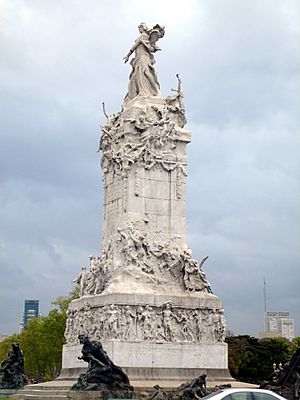
- Cabildo was used as the government house during the colonial times of the Viceroyalty of the River Plate. The original building was finished in 1610 but was soon found to be too small and had to be expanded. Over the years many changes have been made. In 1940, the architect Mario Buschiazzo reconstructed the colonial features of the Cabildo using various original documents.
- Kavanagh building is located at 1065 Florida St. in the barrio of Retiro, overlooking Plaza San Martín. It was constructed in the 1930s in the Rationalist style, by the architects Gregorio Sánchez, Ernesto Lagos and Luis María de la Torre and was finished in 1936. The building is characterised by the austerity of its lines, the lack of external ornamentation and its large prismatic volumes. It was declared a national historical monument in 1999, and is one of the most impressive architectural masterpieces of Buenos Aires. Standing at a height of 120 m, it still retains its impact against the modern skyline of the city. In 1939 its façade received an award from the American Institute of Architects.
- Metropolitan Cathedral is the main Catholic church in Buenos Aires. It is located in the city centre, overlooking Plaza de Mayo, on the corner of San Martín and Rivadavia streets, in the San Nicolás neighbourhood. It is the mother church of the Archdiocese of Buenos Aires.
- National Library is the largest library in Argentina and one of the most important in the Americas.
- The Obelisk was built in May 1936 to commemorate the 400th anniversary of the first founding of the city. It is located in the center of the Plaza de la República (Republic Square), the spot where the Argentine flag was flown for the first time in Buenos Aires, at the intersection of Nueve de Julio and Corrientes avenues. Its total height is 67 meters (220 feet) and its base area is 49 square meters (530 square feet). It was designed by architect Alberto Prebisch, and its construction took barely four weeks.
- The Water Company Palace (perhaps the world's most ornate water pumping station)
-
Las Nereidas font by Lola Mora
Transport
Airports
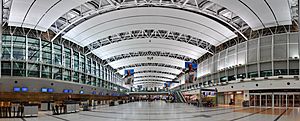
The Buenos Aires international airport, which goes by the official name of Ministro Pistarini International Airport, is located in the suburb of Ezeiza and is often called the "Ezeiza International Airport". The Aeroparque Jorge Newbery airport, located in the Palermo district next to the riverbank, serves only domestic traffic and flights to Brazil, Chile, Paraguay and Uruguay. A smaller San Fernando Airport serves only general aviation.
Local roads and personal transport
Buenos Aires is based on a square, rectangular grid pattern, save for natural barriers or the relatively rare developments explicitly designed otherwise (notably, the neighbourhood of Parque Chas). The rectangular grid provides for square blocks named manzanas, with a length of roughly 110 metres (361 feet). Pedestrian zones in the city centre, like Florida Street are partially car-free and always bustling, access provided by bus and the Underground (subte) Line C. Buenos Aires, for the most part, is a very walkable city and the majority of residents in Buenos Aires use public transport.
Two diagonal avenues in the city centre alleviate traffic and provide better access to Plaza de Mayo. Most avenues running into and out of the city centre are one-way and feature six or more lanes, with computer-controlled green waves to speed up traffic outside of peak times.
The city's principal avenues include the 140-metre (459 ft)-wide July 9 Avenue, the over-35 km (22 mi)-long Rivadavia Avenue, and Corrientes Avenue, the main thoroughfare of culture and entertainment.
In the 1940s and 1950s the General Paz Avenue beltway that surrounds the city along its border with Buenos Aires Province, and the freeways leading to the new international airport and to the northern suburbs, heralded a new era for Buenos Aires traffic. Encouraged by pro-automaker policies that were pursued towards the end of the Perón (1955) and Frondizi administrations (1958–62) in particular, auto sales nationally grew from an average of 30,000 during the 1920–57 era to around 250,000 in the 1970s and over 600,000 in 2008. Today, over 1.8 million vehicles (nearly one-fifth of Argentina's total) are registered in Buenos Aires.
Toll motorways opened in the late 1970s by then-mayor Osvaldo Cacciatore provided fast access to the city centre and are today used by over a million vehicles daily. Cacciatore likewise had financial district streets (roughly one square km in area) closed to private cars during daytime. Most major avenues are, however, gridlocked at peak hours. Following the economic mini-boom of the 1990s, record numbers started commuting by car and congestion increased, as did the time-honored Argentine custom of taking weekends off in the countryside.
Local public transport
Commuter rail
The Buenos Aires commuter network system is very extensive: every day more than 1.3 million people commute to the Argentine capital. These suburban trains operate between 4 am and 1 am. The Buenos Aires commuter rail network also connects the city with long-distance rail services to Rosario and Córdoba, among other metropolitan areas. There are four principal terminals for both long-distance and local passenger services in the city centre: Constitucion, Retiro, Federico Lacroze and Once, while Buenos Aires station is a minor terminus.
Commuter rail in the city is mostly operated by the state-owned Trenes Argentinos, though the Urquiza Line and Belgrano Norte Line are operated by private companies Metrovías and Ferrovías respectively. All services had been operated by Ferrocarriles Argentinos until the company's privatisation in 1993, and were then operated by a series of private companies until the lines were put back under state control following a series of high-profile accidents.
Since 2013, there has been a series of large investments on the network, with all lines (with the exception of the Urquiza Line) receiving new rolling stock, along with widespread infrastructure improvements, track replacement, electrification work, refurbishments of stations and building entirely new stations. Similarly, almost all level crossings have been replaced by underpasses and overpasses in the city, with plans to replace all of them in the near future. One of the most major projects under way is the electrification of the remaining segments of the Roca Line – the most widely used in the network – and also moving the entire section of the Sarmiento Line which runs through the centre of the city underground to allow for better frequencies on the line and reduce congestion above ground.
There are also three other major projects on the table. The first would elevate a large segment of the San Martín Line which runs through the centre of the city and electrify the line, while the second would see the electrification and extension of the Belgrano Sur Line to Constitucion station in the centre of the city. If these two projects are completed, then the Belgrano Norte Line would be the only diesel line to run through the city. The third and most ambitious is to build a series of underground tunnels between three of the city's railway terminals with a large underground central station underneath the Obelisk, connecting all the commuter railway lines in a network dubbed the Red de Expresos Regionales.
Cycling
In December 2010, the city government launched a bicycle sharing program with bicycles free for hire upon registration. Located in mostly central areas, there are 31 rental stations throughout the city providing over 850 bicycles to be picked up and dropped off at any station within an hour. As of 2013[update], the city has constructed 110 km (68.35 mi) of protected bicycle lanes and has plans to construct another 100 km (62.14 mi). In 2015, the stations were automated and the service became 24 hours through use of a smart card or mobile phone application.
Underground
The Buenos Aires Underground (locally known as subte, from "subterráneo" meaning underground or subway), is a high-yield system providing access to various parts of the city. Opened in 1913, it is the oldest underground system in the Southern Hemisphere and oldest in the Spanish-speaking world. The system has six underground lines and one overground line, named by letters (A to E, and H) and there are 100 stations, and 58.8 km (37 mi) of route, including the Premetro line. An expansion program is underway to extend existing lines into the outer neighborhoods and add a new north-south line. Route length is expected to reach 89 km (55 mi) by 2011.
Line A is the oldest one (service opened to public in 1913) and stations kept the "belle-époque" decoration, while the original rolling stock from 1913, affectionately known as Las Brujas were retired from the line in 2013. Daily ridership on weekdays is 1.7 million and on the increase. Fares remain relatively cheap, although the city government raised fares by over 125% in January 2012. A single journey, with unlimited interchanges between lines, now costs AR$3.50, which is roughly USD$0.60.
The most recent expansions to the network were the addition of numerous stations to the network in 2013: San José de Flores and San Pedrito to Line A, Echeverría and Juan Manuel de Rosas to Line B and Hospitales to Line H. Current works include the completion of Line H northwards and addition of three new stations to Line E in the centre of the city. The construction of Line F is due to commence in 2015, while two other lines are planned for construction in the future.
Tramways
Buenos Aires had an extensive street railway (tram) system with over 857 km (533 mi) of track, which was dismantled during the 1960s in favour of bus transportation, but surface rail transport has made a small comeback in some parts of the city. The PreMetro or Line E2 is a 7.4 km (4.6 mi) light rail line that connects with Underground Line E at Plaza de los Virreyes station and runs to General Savio and Centro Cívico. It is operated by Metrovías. The official inauguration took place on 27 August 1987.
A 2 km (1.2 mi) modern tramway, the Tranvía del Este, opened in 2007 in the Puerto Madero district, using two tramcars on temporary loan. However, plans to extend the line and acquire a fleet of trams did not come to fruition, and declining patronage led to the line's closure in October 2012. A heritage streetcar maintained by tram fans operates on weekends, near the Primera Junta line A Underground station in the Caballito neighbourhood.
Buses
There are over 150 city bus lines called Colectivos, each one managed by an individual company. These compete with each other, and attract exceptionally high use with virtually no public financial support. Their frequency makes them equal to the underground systems of other cities, but buses cover a far wider area than the underground system. Colectivos in Buenos Aires do not have a fixed timetable, but run from four to several per hour, depending on the bus line and time of the day. With inexpensive tickets and extensive routes, usually no further than four blocks from commuters' residences, the colectivo is the most popular mode of transport around the city.
Buenos Aires has recently opened a bus rapid transit system, the Metrobus. The system uses modular median stations that serve both directions of travel, which enable pre-paid, multiple-door, level boarding. The first line, opened on 31 May 2011, runs across the Juan B. Justo Ave has 21 stations. The system now has 4 lines with 113 stations on its 43.5 km (27.0 mi) network, while numerous other lines are under construction and planned.
Taxis
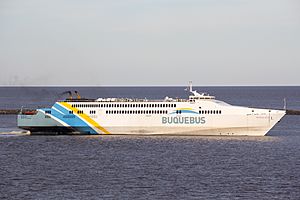
A fleet of 40,000 black-and-yellow taxis ply the streets at all hours. License controls are not enforced rigorously. There have been reports of organized crime controlling the access of taxis to the city airports and other major destinations. Taxi drivers are known for trying to take advantage of tourists. Radio-link companies provide reliable and safe service; many such companies provide incentives for frequent users. Low-fare limo services, known as remises, have become popular in recent years.
Ferries
Buenos Aires is also served by a ferry system operated by the company Buquebus that connects the port of Buenos Aires with the main cities of Uruguay, (Colonia del Sacramento, Montevideo and Punta del Este). More than 2.2 million people per year travel between Argentina and Uruguay with Buquebus. One of these ships is a catamaran, which can reach a top speed of about 80 km/h (50 mph).
Public Transportation Statistics
According to data released by Moovit in July 2017, the average amount of time people spend commuting with public transit in Buenos Aires, for example to and from work, on a weekday is 79 min. 23% of public transit riders, ride for more than 2 hours every day. The average amount of time people wait at a stop or station for public transit is 14 min, while 20% of riders wait for over 20 minutes on average every day. The average distance people usually ride in a single trip with public transit is 8.9 km, while 21% travel for over 12 km in a single direction.
| Provinces of Argentina | |
|---|---|
| Buenos Aires | Buenos Aires Province | Catamarca | Chaco | Chubut | Córdoba | Corrientes | Entre Ríos | Formosa | Jujuy | La Pampa | La Rioja | Mendoza | Misiones | Neuquen | Río Negro | Salta | San Juan | San Luis | Santa Cruz | Santa Fe | Santiago del Estero | Tierra del Fuego, Antarctica, and South Atlantic Islands | Tucumán | |
Images for kids
-
Construction of the Obelisk of Buenos Aires on the 9 de Julio Avenue, 1936.
-
The Metropolitan Cathedral is the main Catholic church in the city.
-
Monument to the Carta Magna and Four Regions of Argentina in the neighborhood of Palermo
-
Homage to Buenos Aires, a mural located at the Carlos Gardel station of the Buenos Aires Underground. It represents a typical scene from the city and several of its icons, such as singer Carlos Gardel, the Obelisco, the port, tango dancing and the Abasto market.
-
University of Buenos Aires' Law School in Recoleta
-
La Bombonera during a night game of Copa Libertadores between Boca Juniors v. Colo Colo.
See also
 In Spanish: Buenos Aires para niños
In Spanish: Buenos Aires para niños




